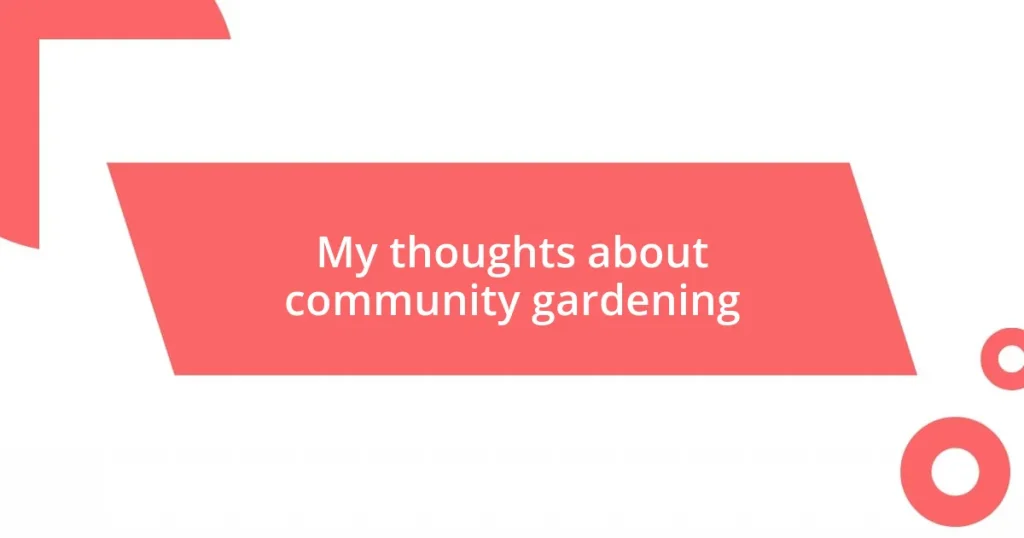Key takeaways:
- Community gardening fosters social connections, reduces stress, and contributes to food security by providing fresh produce.
- Key steps to start a community garden include gathering a group, choosing a location, planning the garden, organizing resources, and setting a schedule.
- Choosing the right plants involves considering climate, soil type, and gardener preferences, and engaging the community in the selection process strengthens bonds.
- Celebrating successes, such as harvest festivals and educational workshops, enhances community spirit and inspires future generations to appreciate nature.
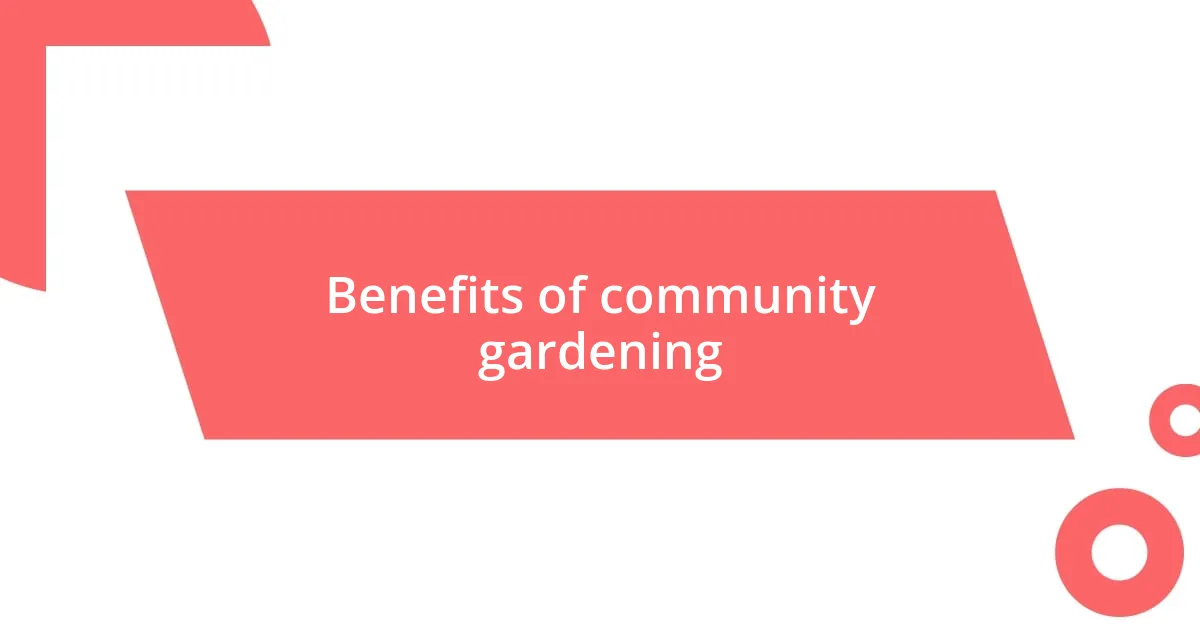
Benefits of community gardening
Community gardening offers a wonderful opportunity to foster social connections within a neighborhood. I remember the first time I got my hands dirty in a local garden; it wasn’t just about planting seeds but about meeting people from different walks of life. Isn’t it fascinating how a simple activity can bridge gaps and create friendships?
Moreover, the health benefits of community gardening cannot be overlooked. Spending time outdoors, digging in the soil, and nurturing plants can reduce stress and improve mental well-being. Personally, I find that there’s something incredibly therapeutic about tending to a garden—it’s like the worries of the day melt away with every weed I pull. Can you think of a better way to boost your mood?
Lastly, community gardens contribute to food security, allowing access to fresh produce in urban areas where grocery stores might be scarce. I often find that the tomato I grow tastes far better than anything from the supermarket, and sharing the bounty with neighbors adds an extra layer of joy. How rewarding is it to know you’re part of a solution for healthier eating in your community?
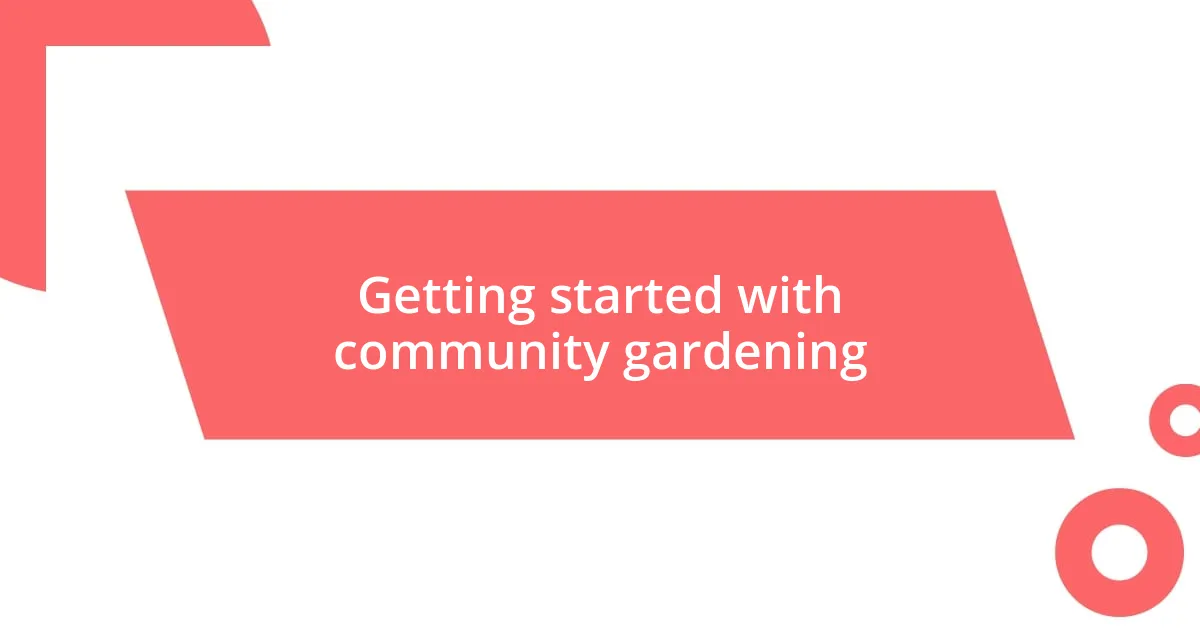
Getting started with community gardening
To embark on your community gardening journey, it’s crucial to find or create a space that resonates with you and fellow gardeners. This could be an empty lot, a shared backyard, or even a local park area. When I first joined my community garden, I was surprised to discover not just a patch of soil, but a canvas for creativity and collaboration. The excitement of starting something new with others who share the same vision is truly invigorating.
Here are some steps to help you get started:
- Gather a group: Connect with neighbors or friends who are interested in gardening.
- Choose a location: Look for available community land or partner with local organizations.
- Plan your garden: Decide on the types of plants to grow based on the space and preferences of the group.
- Organize resources: Pool together tools, seeds, and soil. It feels great when everyone contributes!
- Set a schedule: Regular meetings ensure everyone is involved and excited about the progress.
As you develop your plans, working together on tasks becomes a bonding experience. Each plant you nurture together can represent a step towards shared goals and friendships, transforming the space into a synergy of creativity and connection. I remember how, during our first planting day, a simple moment of laughter while we struggled to turn the soil made it clear—we were not just creating a garden; we were cultivating community.
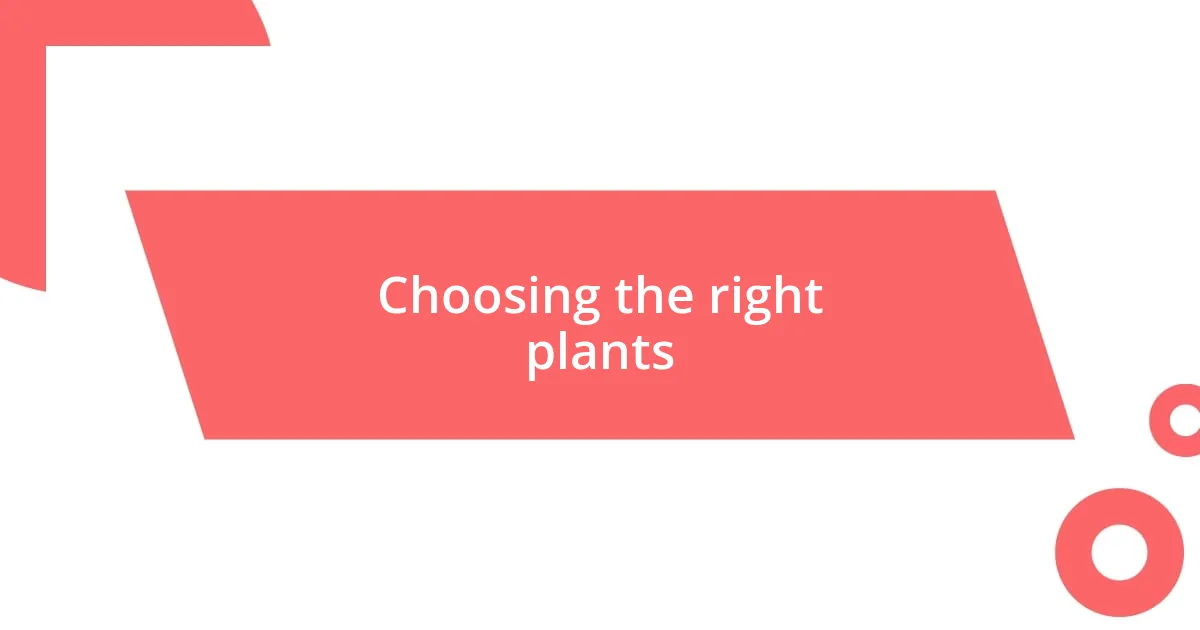
Choosing the right plants
Choosing the right plants for your community garden can be both exciting and a bit daunting. I remember when I first attempted to create a vegetable patch; I was overwhelmed by the vast variety of options. It’s important to consider factors like the climate, soil type, and the preferences of fellow gardeners. For instance, if you live in a region with a hot climate, selecting drought-resistant varieties not only ensures a better yield but also makes gardening less labor-intensive.
When I reflect on my experience with plant selection, I realize that it’s also about what will thrive in your community’s environment. Engaging fellow gardeners in the decision-making process can lead to growing both shared favorites and unique varieties that everyone can enjoy. That moment when we collectively decided to plant heirloom tomatoes one season was pure joy. Not only did we get to share our gardening knowledge, but we also created a stronger bond as we anticipated the delicious harvest.
Now, let’s break down some plant options into a comparative table that showcases various types of plants suitable for community gardens based on different criteria.
| Type of Plant | Light Requirements | Water Needs | Growth Duration |
|---|---|---|---|
| Tomatoes | Full Sun | Moderate | 75-85 days |
| Lettuce | Partial Shade | High | 30-70 days |
| Zucchini | Full Sun | Moderate | 45-60 days |
| Herbs (e.g., Basil) | Full Sun | Low | 60-90 days |
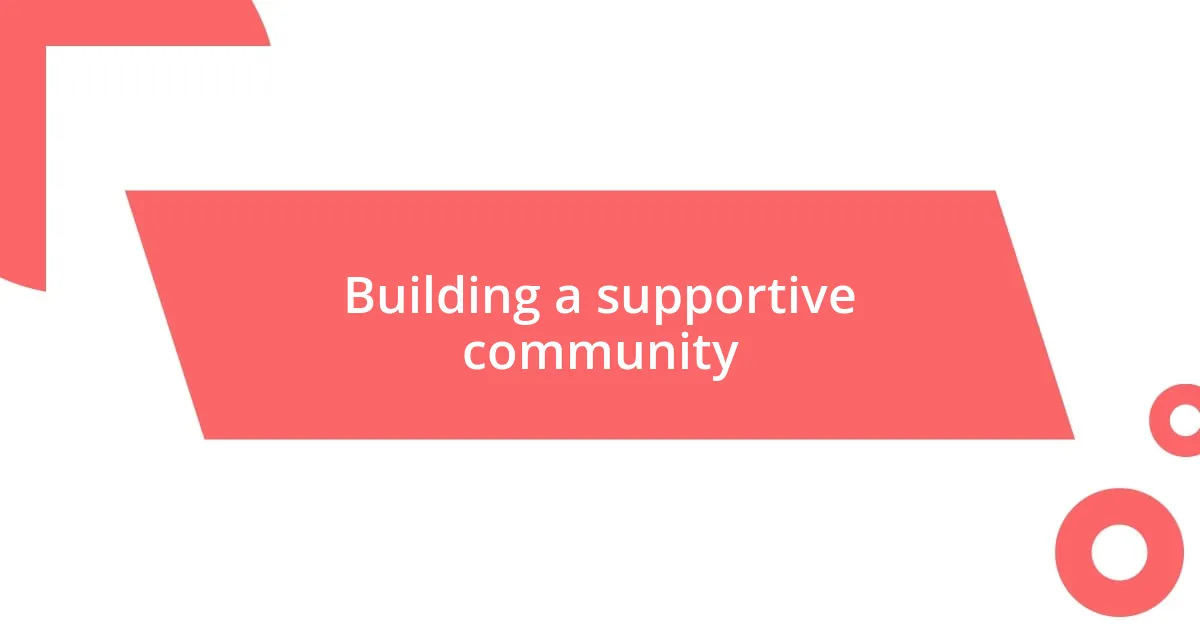
Building a supportive community
Building a supportive community within a garden can truly transform the experience for everyone involved. I vividly recall the first time our group organized a potluck to celebrate our progress. It was more than just sharing dishes; it felt like the official welcome into a family of gardeners. The laughter, stories, and shared struggles over gardening mishaps helped strengthen our bonds beyond just plants. Isn’t it amazing how a shared meal can draw people closer together?
Engaging each member actively in the garden’s development fosters a sense of ownership and pride. I learned this firsthand when we instituted a “buddy system” for new members, pairing them with seasoned gardeners. The smiles on their faces as they exchanged tips and shared their experiences made it clear that support is foundational. Have you ever noticed how simple acts of encouragement can make everyone feel valued? It’s those little gestures that turn our gardening efforts into meaningful relationships.
Moreover, regular group gatherings, whether for planning sessions or just to enjoy the garden, can enhance that community spirit. I remember hosting a monthly garden walk where everyone showcased their favorite plants and shared advice. These gatherings didn’t just provide useful gardening insights, but also created a safe space to discuss personal stories and challenges. Isn’t it wonderful how nature can serve as a backdrop for deep connections? Those moments helped us to grow together, quite literally and metaphorically!
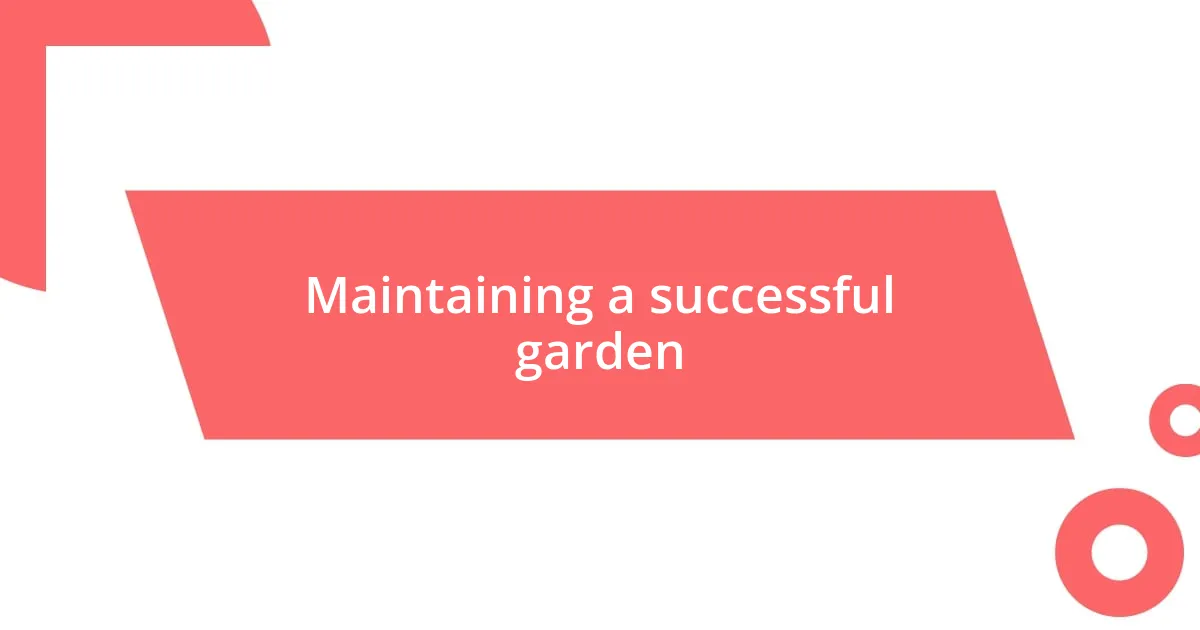
Maintaining a successful garden
Maintaining a garden requires regular attention, which can be quite rewarding if you approach it with care and willingness to learn. I remember the first time I let my weeds grow too tall—it felt overwhelming! Regular weeding not only enhances the garden’s appearance but also helps plants absorb more nutrients from the soil. Have you ever found yourself lost in a sea of green? Keeping a consistent schedule for maintenance can really make a difference in productivity and overall health.
Watering is another critical aspect of garden care. I’ve learned that it’s not just about frequency but also timing. I prefer watering in the early morning to reduce evaporation and prevent diseases. It’s amazing how a small change in approach can have significant effects, isn’t it? One summer, when I forgot to adjust my watering schedule, I noticed my tomato plants drooping, and it broke my heart. That experience taught me to listen to my garden—just as our plants rely on us, we must observe their needs closely.
Finally, incorporating seasonal rotations can enhance soil health and prevent pest outbreaks. I once experimented with rotating my crops based on what had been planted in the previous year, and the results were evident. More robust plants and fewer pests—not to mention a thriving community of beneficial insects! Have you thought about how simple shifts in planning can yield such positive outcomes? Learning to be adaptable and attentive turned my garden into a vibrant ecosystem that gives back more than I could have imagined.
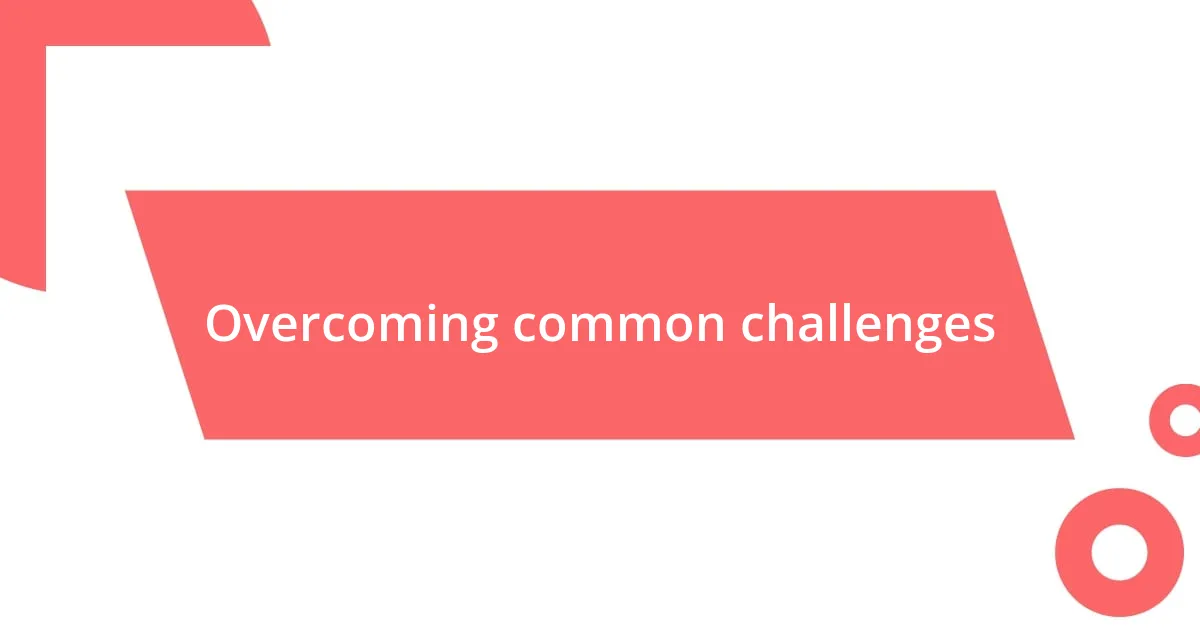
Overcoming common challenges
Overcoming challenges in community gardening often means tackling the unpredictability of nature together. When our group faced an unexpected drought one summer, I remember the concern on everyone’s faces as we gathered and brainstormed solutions. We decided to build a rainwater collection system, and seeing the enthusiasm as neighbors worked together to set it up reminded me that every obstacle could become an opportunity for teamwork. Have you ever felt a sense of accomplishment just by collaborating with others?
Another common hurdle is managing differing opinions among garden members. In my experience, conflict sometimes arises over what to plant or how to maintain the space. I recall a spirited debate about whether to plant tomatoes or herbs, which ended with us creating dedicated sections for both. It was enlightening to see everyone come together to find a compromise, making the garden not just a place for plants, but a canvas for creativity. Isn’t it fascinating how negotiation can lead to shared ownership and enhanced beauty?
Funding and resource allocation can also pose significant challenges. I once led an initiative to host a local fundraising event, where we showcased our garden and invited the community to contribute. Watching the support roll in from nearby businesses and neighbors was incredibly heartwarming. It reinforced my belief that when we openly communicate our needs and aspirations, people are often willing to help. Have you thought about how a simple conversation could unlock new resources for your garden?
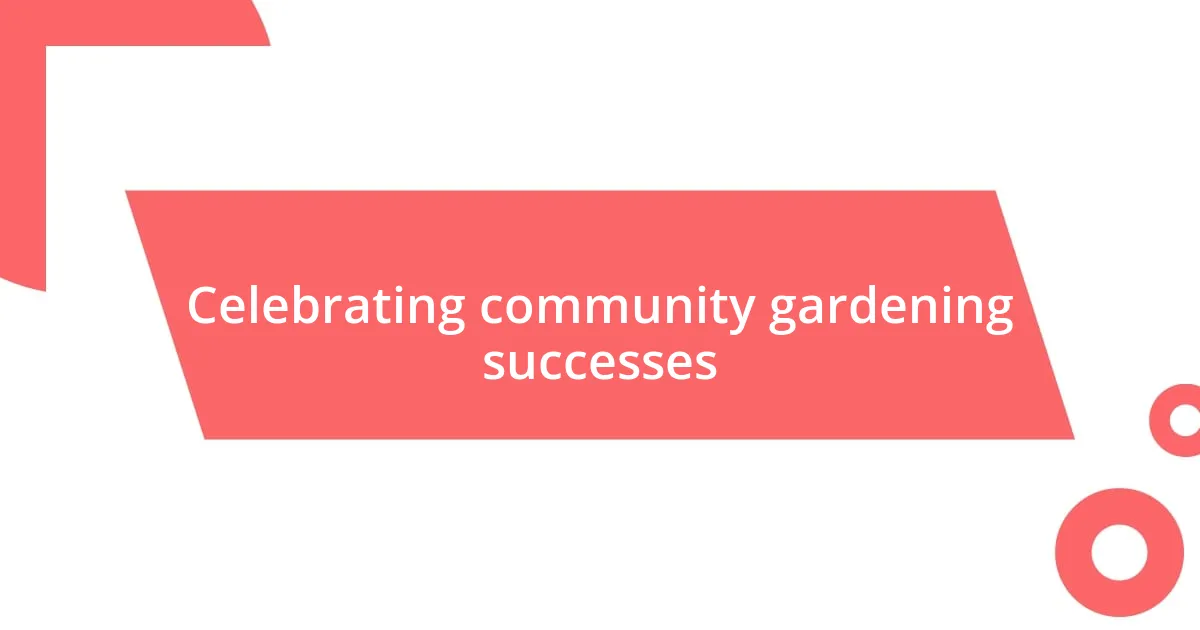
Celebrating community gardening successes
Community gardening successes often shine brightest when we celebrate our harvests together. I vividly recall the joy we felt during our annual harvest festival, where the fruits of our labor transformed into a vibrant feast. Each dish made with fresh produce from our garden was a testament to our teamwork and dedication. Have you ever tasted something so rewarding that it brought people closer? Sharing meals created a connection that extended beyond gardening; it forged friendships and strengthened our community fabric.
Another highlight of our gardening journey was the introduction of educational workshops for local kids. I volunteered to teach a class on planting seedlings, and the excitement in those little eyes as they buried their seeds was unforgettable. The experience reminded me of how community gardening can inspire the next generation, teaching them not just about plants but also nurturing a sense of responsibility and respect for nature. Have you thought about the potential of your garden to spark curiosity and creativity in young minds?
Moreover, witnessing the garden flourish with diverse flora has sparked countless moments of pride among us. One unforgettable moment was when we transformed a neglected corner of the plot into a butterfly garden. I remember the fluttering wings, drawing curious visitors and inspiring conversations about pollinators. It was incredible to see how our efforts not only beautified the space but also contributed to the ecosystem. How often do we acknowledge the broader impact of our gardening successes on wildlife and our environment?










